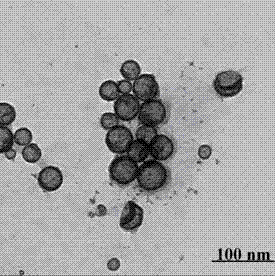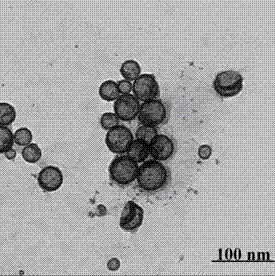PtNi alloy/graphene combined nanometer catalyst with hollow structure and preparation method thereof
A graphene composite and nano-catalyst technology, applied in metal/metal oxide/metal hydroxide catalysts, physical/chemical process catalysts, chemical instruments and methods, etc. Electrocatalytic performance and other issues, to achieve excellent electronic conductivity, excellent catalytic performance, and reduce costs
- Summary
- Abstract
- Description
- Claims
- Application Information
AI Technical Summary
Problems solved by technology
Method used
Image
Examples
Embodiment 1
[0034] 1 mg graphene oxide was ultrasonically dispersed in 10 mL of polyvinylpyrrolidone (PVP) aqueous solution with a concentration of 10 g / L, and then 10 mL of nickel chloride solution with a concentration of 2 mmol / L was added, magnetically stirred, and high Pure nitrogen for 15 min. Then the temperature was controlled at 25 °C, and 30 mL of newly prepared sodium borohydride solution with a concentration of 50 mmol / L was added dropwise. Potassium acid solution, after the dropwise addition, continue to stir and react for 2 h. The reaction product was centrifuged, washed, and dried at 60 °C to obtain a hollow structure PtNi alloy / graphene composite nanocatalyst. The particle size of the PtNi nanoalloy hollow sphere was 10-50 nm, and the ratio of the amount of Pt to Ni was 5:1.
Embodiment 2
[0036]1 mg graphene oxide was ultrasonically dispersed in 10 mL of 20 g / L polyvinylpyrrolidone (PVP) aqueous solution, then 15 mL of 2 mmol / L nickel chloride solution was added, magnetically stirred, and high Pure nitrogen for 15 min. Then the temperature was controlled at 25 °C, and 30 mL of newly prepared sodium borohydride solution with a concentration of 50 mmol / L was added dropwise. Potassium acid solution, after the dropwise addition, continue to stir and react for 2 h. The reaction product was centrifuged, washed, and dried at 60 °C to obtain a hollow structure PtNi alloy / graphene composite nanocatalyst. The particle size of the PtNi nanoalloy hollow sphere was 10-50 nm, and the ratio of the amount of Pt to Ni was 3:1.
Embodiment 3
[0038] 2 mg graphene oxide was ultrasonically dispersed in 10 mL of 30 g / L polyvinylpyrrolidone (PVP) aqueous solution, then 20 mL of 2 mmol / L nickel chloride solution was added, magnetically stirred, and high-purity Nitrogen for 15 min. Then the temperature was controlled at 35 °C, and 20 mL of newly prepared sodium borohydride solution with a concentration of 50 mmol / L was added dropwise. Potassium acid solution, after the dropwise addition, continue to stir and react for 2 h. The reaction product was centrifuged, washed, and dried at 60 °C to obtain a hollow structure PtNi alloy / graphene composite nanocatalyst. The particle size of the PtNi nanoalloy hollow sphere was 10-50 nm, and the ratio of the amount of Pt to Ni was 2:1.
PUM
| Property | Measurement | Unit |
|---|---|---|
| particle diameter | aaaaa | aaaaa |
| particle size | aaaaa | aaaaa |
Abstract
Description
Claims
Application Information
 Login to View More
Login to View More - R&D
- Intellectual Property
- Life Sciences
- Materials
- Tech Scout
- Unparalleled Data Quality
- Higher Quality Content
- 60% Fewer Hallucinations
Browse by: Latest US Patents, China's latest patents, Technical Efficacy Thesaurus, Application Domain, Technology Topic, Popular Technical Reports.
© 2025 PatSnap. All rights reserved.Legal|Privacy policy|Modern Slavery Act Transparency Statement|Sitemap|About US| Contact US: help@patsnap.com



